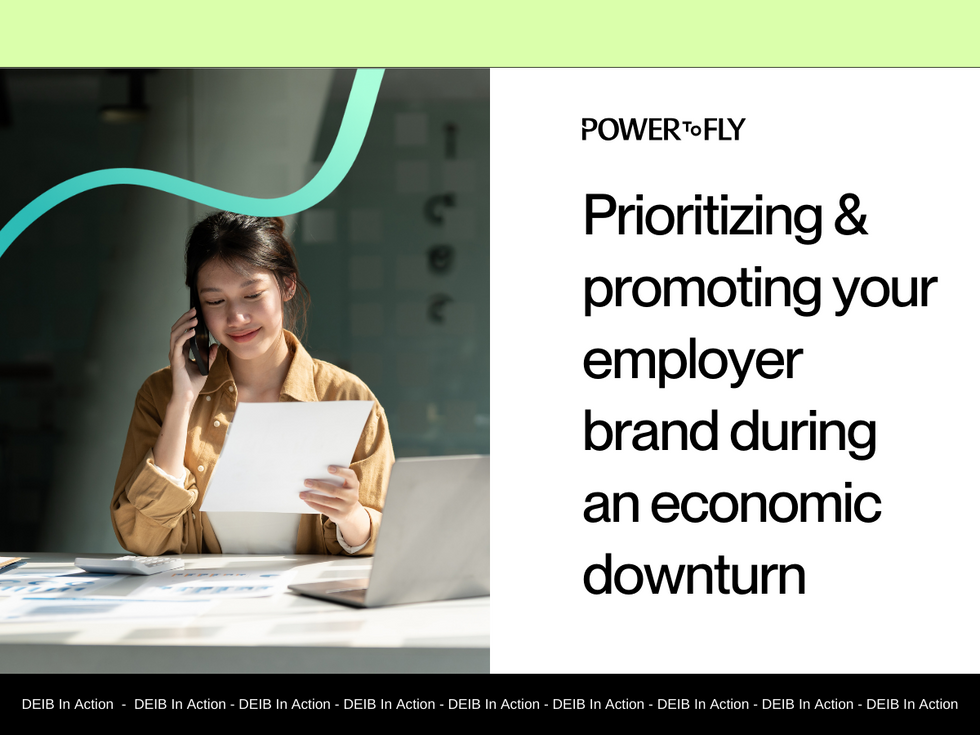To start us off with an employer branding definition, your employer brand is the impression you’ve put (intentionally or inadvertently) out in the job market of what working at your organization is actually like. Why is that impression so important? Because employer branding directly affects the quality of talent you attract. It also affects the amount of money you spend attracting that talent.
A study from Robert Half showed that 91% of new hires are willing to quit a new job in the first month and 28% actually do quit before 90 days. That study found 44% of those who left in the first month experienced a “discrepancy” between the job in practice and how it was advertised. Another 38% cited company culture. To avoid missing out on high-quality talent, let’s look at employer branding strategies for 2024 through the lens of mistakes that brands should avoid making in the current job climate.
Mistake #1: Ignoring employee feedback
One of the first employer branding mistakes in 2024 can be avoided simply by listening to your people. The most obvious thing we can take away from employee experience research is that people love working for a brand that listens.
Employees, as well as potential employees, are the experts on your company's employer branding. Whether it’s in their day-to-day work and interactions with management or in the job application process, employees and candidates know how employer branding has affected them. Companies that are not asking employees for their feedback or those that do nothing with feedback they’ve been generously given, are missing a golden opportunity.
The solution.
Build-in a robust feedback loop where you regularly ask your employees for their impressions via forums like employee surveys. This is particularly important at touchpoints where emotions run high, such as rejecting a candidate application or during annual performance evaluations. Asking “how was that experience for you?” is not only a powerful way to show you care. It’s important market research in much the same way marketing teams ask customers about their experience.
Collecting this information is just step one. Ensure that precious market research doesn’t go to waste by having policies and procedures to review it and take action based on that feedback.
Mistake #2: Not conducting an employer branding audit
A second major mistake to avoid is not getting an accurate temperature check on the state of your employer brand today. As mentioned, both candidate engagement and employee experience combine to form the general impression of your brand as an employer in the job market.
Marketing 101 tells us that negative brand perception from audiences is damaging to sales. In the same way, negative perceptions of your employer brand damages your ability to hire and maintain top talent. Not realizing these perceptions are already out there and sticking your head in the sand will get you nowhere. So, how do you know what impressions of your brand currently exist?
The solution.
There are three basic things you can do to nip negative employer branding perceptions in the bud. First, collect feedback through interviews and surveys, as suggested in the previous section. Then, conduct an employer branding audit. An audit involves understanding candidate and employee feelings towards your organization and understanding your resulting market position in their minds. That’s for current staff.
For impressions of employer branding in recruitment, take a look at your external branding. Assess your websites, social networks, and logos to see what people are saying as candidates. Finally, put external and internal impressions together. This will give you a clear employer branding strategy with goals and metrics to maintain the positive and deal with the negative perceptions you’ve uncovered through your research.
Mistake #3: Not walking the walk
Slick, high-quality videos and marketing material mean nothing if the work environment doesn’t match what was promised.
The solution.
Your employer branding should give an honest impression of what it’s like to work in the company on a day-to-day basis. The easiest way to achieve that is to incorporate employee voices in marketing materials — let them be the ones to describe what it’s like to work at the company.
Boost your employer brand with PowerToFly
A strong employer brand:
✔️ Reduces cost-per-hire by 50%
✔️ Reduces turnover by 25%
✔️ Makes hiring 1-2x faster
We'll help you turn your employer brand into a vehicle for increasing visibility and recognition with top, diverse talent, all while highlighting your values and affirming your commitment to fostering a diverse and inclusive workplace.
Explore employer brand solutions
Mistake #4: A poor digital presence
The first thing a candidate is likely to do after seeing a job posting is visit the company’s website and its social media: Instagram, LinkedIn, X (formerly Twitter), Facebook, etc. If they find that their preferred social media is inactive, it’s off-putting. A poor digital presence hampers engagement and makes your organization look less relevant.
The solution.
Keep your organization’s social media active. Make sure to post about employee and candidate topics alongside marketing campaigns to customers. For LinkedIn especially, it’s important to produce inclusive job descriptions that mitigate bias and focus on actual requirements and tasks.
Don’t forget to utilize social media to engage with certain age groups or generations. Pew Research found that platforms like Instagram, Snapchat, and TikTok are more popular among 18-29 year olds while Facebook remains popular for 30-49 year olds. YouTube is widely used among both age groups. Tailor your messaging to a multigenerational workforce for stronger employer branding.
Mistake #5: A lack of community engagement
One-off events and fundraisers are nice, but without structure, strategy, or real follow-up, they don’t represent true community engagement. That playground co-sponsored by your organization looks good when it’s new, but what happens when it needs repairs and some TLC? You don’t want your organization’s name on a dilapidated playground. A lack of profound community engagement, or even half-hearted attempts, can detract from your employer branding.
The solution.
Your organization probably has some form of community engagement in place, whether that’s employee giving or volunteerism. Ensure that there is a budget and an oversight committee to keep these programs and the relationship with community organizations active. These could be churches, schools, community colleges, chamber of commerce, etc. Hiring from your local community through these relationships as well as through public events like job fairs is a great diversity recruitment strategy.
Mistake #6: A lack of transparency
A lack of transparency in the hiring and recruitment processes has a number of consequences for talent. It sets candidates out on a bad foot, increasing chances of a negative candidate experience. It can also lead to poor communication, reduced diversity, and disengaged talent. For existing employees, a lack of transparency drives mistrust and misunderstanding of management, administration, and procedures at your organization.
The solution.
Prioritize honest and personalized communication with candidates and staff. Avoid using stock emails to communicate rejection or acceptance. If you are rejecting a candidate, give detailed, personalized feedback as to why. For employees, be clear about benefits available to them based on their specific needs. Share procedures for grievances and whistleblowing openly. This creates a sense of trustworthiness in your employer branding.
Mistake #7: Not having a unique value proposition
Your marketing team likely has created a unique value proposition (UVP) for your product or service. A UVP is a clear, simple statement about how your product is different. Your employer branding needs an employer value proposition. Without it, there is no way to answer a potential employee’s query of “why should I work for you?” In the competitive job market of 2024, top candidates are assessing employers, not just the other way around.
The solution.
Write your company's employer UVP in plain words so it’s easy to leverage as a tool. Your employer UVP should align with your mission and values but focus on what you can offer people in order to drive that mission. Your unique value proposition helps to conceptualize your employer branding in more concrete terms.
Mistake #8: Thinking short-term
It might be easy to send an email from a template when rejecting a candidate or to not bother communicating at all. Maybe it saves time by rushing through some onboarding processes with a new hire. Or you might tell yourself that if there are problems between management and staff, someone will inform you. Not great in practice.
In the long-term, these behaviors cause negative experiences for employees and candidates. A study by IBM showed that negative candidate experiences have far-reaching effects on companies. Negative experiences mean the candidate won’t accept job offers, won’t recommend the company to others, and won’t be ambassadors or even customers of the brand.
Our own research for our flagship What Diverse Talent Wants: 2024 report found that 64% of underrepresented workers have had a negative candidate experience that hurt their relationship with the company long-term, with 27% of this talent group saying they would neither apply to or shop from that company again.
The solution.
Think long-term and take steps to build a positive candidate experience. Make it easy to apply, communicate regularly, and reduce bias in the screening process.
Another aspect of thinking long-term is to build your employer branding even at a time when you aren’t on a hiring spree. PowerToFly produced a special report on the topic that is download-worthy. Take a look at how you can maintain a strong employer brand regardless of current hiring rates:
Get the free report
Mistake #9: Not incorporating belonging
Diversity is important to employees and to a company's bottom line. That’s why 83% of companies have DEI initiatives in place. While diversity, equity, and inclusion are parts of creating an open and supportive workplace, it’s critical to incorporate belonging into your DEI strategy. At work, belonging represents a feeling of being genuinely welcome to participate, secure in one’s role, and connected to colleagues. If employees don’t feel like they belong, they’re not going to stay.
The solution.
Make belonging a genuine intention of your DEI, or DEIB, strategy. Safety, social connection, and open communication are just a few of the elements of belonging. Promoting psychological safety is a key part of fostering belonging, as well. Employees need to feel comfortable with speaking up without fear of judgment or retaliation.
Mistake #10: Not addressing expectations
Candidates today have different expectations about work, covering not only salary and benefits but also expectations about how, when, and where they work. Companies that are unaware of or that don’t address these expectations risk missing out on top talent.
The solution.
Offer hybrid and remote work options for employees as well as salary transparency for both candidates and existing talent. Across all generations of workers, remote working options are a leading benefit that professionals look for in an employer. And when it comes to transparent pay, more and more states are making requirements for posting salary ranges in job descriptions. Job postings that include a salary range will receive more interest from top talent. LinkedIn found that 82% of survey respondents reported that seeing a salary range in a job posting gave them a more positive impression of the company.




